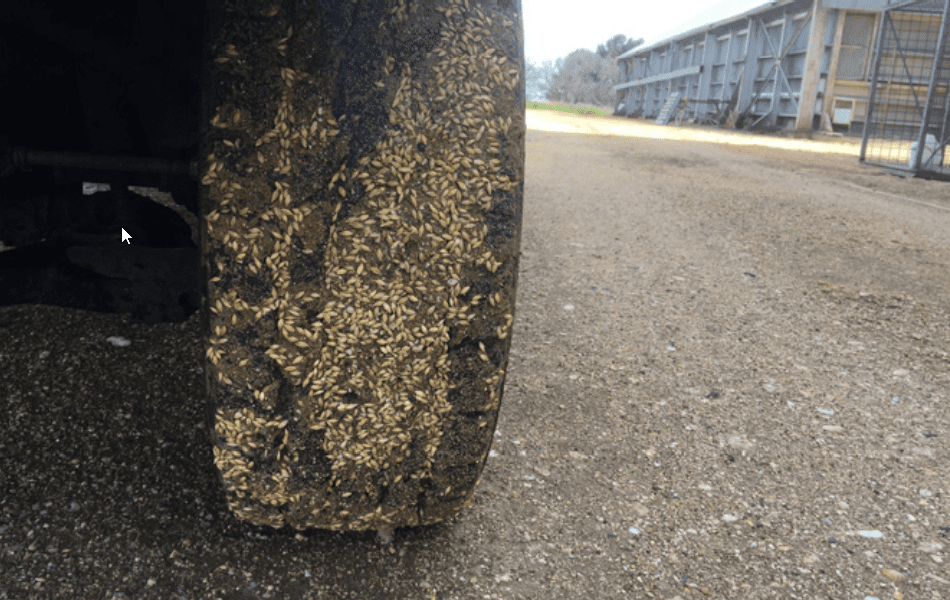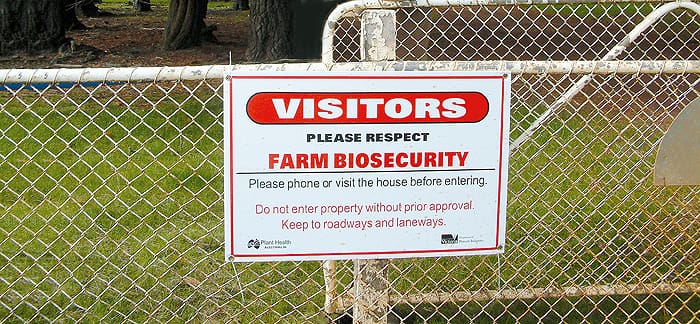
Vehicle and machinery movements can pose a biosecurity risk on farms if proper precautions aren’t taken. Photo: Grains Farm Biosecurity Program
GRAIN Producers Australia (GPA) is encouraging growers and property managers to use the new Vehicle Biosecurity Risk Assessment Tool to help prevent deadly pests and diseases hitchhiking their way onto farms.
The new tool was designed for people in the grains industry to assess and identify biosecurity risks with vehicle and machinery movements.
GPA chair, Barry Large, said tiny pests such as khapra beetle had the potential to cause significant social and economic devastation for the Australian grains industry, impacting international trade.
Mr Large – who also chairs the GPA Biosecurity Committee – said the tool was a simple and effective way to support growers to take action and improve biosecurity management, to protect their own businesses and the broader grains industry.
“The tool is one of those ‘one percenters’ we can all use on our farms to make a difference,” Mr Large said.
“It’s designed so farmers can take control of people, vehicles and machinery that enter their property; especially the productive zones.
“It’s a prompt for a discussion that’s needed to keep risky vehicles and machines off the property until thar risk has been properly managed by cleaning etc.
“The checklist hopes to prompt a level of responsibility in people moving and travelling from farm to farm, to thoroughly clean down prior to entering a property, as a duty of care to the owner.”
Mr Large said the tool was developed by the Grains on Farm Biosecurity Program, which is managed through Plant Health Australia and GPA, in representing Australia’s levy-paying grain producers.
Grains Industry Biosecurity Officers work in each of Australia’s major grain producing states, along with state governments, delivering practical tools and programs to help manage on-farm biosecurity risks, and increase preventative measures, to safeguard growers and industry.
Quick assessment strategy
Agriculture Victoria grains biosecurity officer Jim Moran said the tool provides a quick reference guide for assessing a vehicle that has travelled off a property or is not stationed on a property.
“If a vehicle has travelled off your property, this useful vehicle biosecurity risk assessment checklist helps you decide if it requires a clean down before re-entering, to prevent the introduction of pests and diseases on farm,” Mr Moran said.

A vehicle biosecurity kit may be useful to have on hand if a vehicle needs to be cleaned. Photo: Grains Farm Biosecurity Program
Mr Moran said the checklist gave grain growers a quick assessment strategy to help them determine if a vehicle requires a clean down before re-entering their property.
He said, for example, the checklist suggests key questions to consider when a vehicle either arrives or re-enters, such as: where has the vehicle been and what is the likelihood it has come into contact with weeds or other pests.
“It asks whether the road conditions were dry, damp, muddy or flooding – because these will all have an impact on the level of risk the vehicle represents to your farm.”
GPA northern director and Moree grain farmer, Matthew Madden said the checklist included prompts about road surfaces travelled (including paddocks) and their corresponding biosecurity risk level ratings.
“If it’s wet, forget it. Vehicles shouldn’t be entering the productive areas of your property when it is wet or flooded unless there is an urgent need,” Mr Madden said.
“Mud sticks to tyres and is flicked up into the hard to see and clean components, giving weeds, pests and diseases, a ride to the next paddock or property.
“Flood water behaves similarly, washing muddy water over vehicles and machinery but also can provide a means of transport for weeds, pests and diseases, spreading around the property or district as it moves.
“The best tactic is not drive onto muddy or flooded paddocks and protect your farm’s production zones from the introduction and spread of pests, weeds and diseases.”

Farm biosecurity signs can be another great preventative measure. Photo: GRDC
Be proactive against pests, diseases
AgForce Grains president, and Darling Downs grain producer, Brendan Taylor, said farmers and property managers can also use other preventative measures to protect against pests and diseases.
Mr Taylor said growers can install free farm biosecurity signs – available through state Grains Biosecurity Officers – to hang on their front gates.
“These signs clearly demonstrate to all visitors that biosecurity is a serious matter on your farm and everyone needs to do the right thing, with the same level of concern and responsibility,” Mr Taylor said.
Grain Producers South Australia chair, Adrian McCabe said another proactive measure was having a designated parking area for visitors where the farmer or property manager can ask vital questions about the visitor’s prior whereabouts, and perform a thorough inspection, using the Tool’s checklist as a guide.
“You can also be better prepared by installing a high pressure wash down area away from the property’s production,” Mr McCabe said.
“Undertaking vigilant and frequent surveillance to find any pests, weeds or diseases early, makes eradication more likely.
“Report anything unusual to the exotic plant pest hotline 1800 084 881.”
Source: GPA

HAVE YOUR SAY